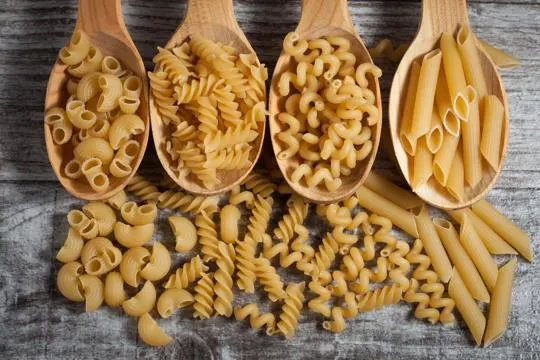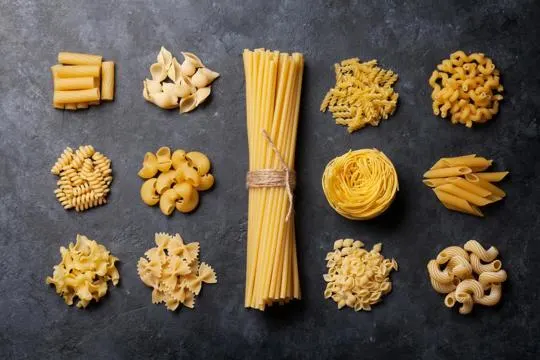Summary of key points
The main difference between gluten-free pasta and regular pasta is the type of flour used. Regular pasta is made with wheat flour, which contains gluten, while gluten-free pasta can be made with alternative flours such as rice or corn.
In terms of taste and texture, gluten-free pasta may have a slightly different flavor and consistency compared to regular pasta. However, there are many options available now that closely mimic the taste and texture of traditional pasta.
It’s important to note that gluten-free pasta is necessary for those with celiac disease or gluten intolerance, while regular pasta can be enjoyed by anyone.
When it comes to cooking, both types of pasta can be boiled in water until al dente, but gluten-free pasta may need to be watched more closely as it can become mushy if overcooked.
Ever tried to swap your beloved spaghetti for the gluten-free kind? We did. Spoiler alert: it’s a wild ride.
Gluten-free pasta tosses out wheat in favor of things like rice, corn, or quinoa. The goal? To be a friend to those with gluten issues. Yet, everyone’s joining the bandwagon, not just the gluten-sensitive gang.
We’ve been there, debating in the grocery aisle. Is it worth it? Here’s the lowdown from our kitchen to yours.
We found that gluten-free pasta can have a different texture and flavor. Some of us loved it, some missed the chewiness of regular pasta.
Try it. You might be surprised. Or you might run back to your wheaty noodles. Either way, it’s a ride.
What is Gluten-Free Pasta?

Gluten-free pasta is a great option for those unable to eat wheat, barley, or rye.
It’s made from alternative flours like rice, corn, or quinoa.
This means those with gluten sensitivity or celiac disease can still enjoy pasta dishes without ill-effects.
Gluten-free pasta offers a similar texture and taste to regular pasta.
Plus, it’s often enriched with vitamins and minerals to make up for the nutrients missing without wheat flour.
The cooking time for gluten-free pasta is different than regular pasta.
It takes 8-10 minutes for regular pasta to cook al dente, while gluten-free pasta needs closer attention.
It cooks faster and can become mushy if overcooked, so follow instructions on the packaging and test the texture often.
Nutritionally, gluten-free pasta may vary from regular pasta.
Regular pasta has more protein and fiber due to its wheat content, whereas gluten-free options depend on the alternative flour used.
What is Regular Pasta?

Regular pasta – a classic in many households worldwide – is composed of durum wheat flour and water (sometimes with eggs).
It comes in various shapes and sizes, like spaghetti, penne, or linguine.
This pasta is renowned for its versatility – it can be used in traditional Italian recipes, as well as international cuisines.
When cooked al dente, it’s firm and chewy, providing a satisfying bite.
Its texture comes from gluten – a protein that gives it elasticity.
The dough is kneaded until smooth, then shaped into different forms.
Cooking time varies, but usually takes 8 to 12 minutes.
Regular pasta is a good source of carbohydrates and fiber.
It can provide energy for daily activities and promote digestive health.
When combined with nutrient-rich sauces or toppings, it can contribute to balanced meals that satisfy hunger.
In conclusion, regular pasta is a beloved food, cherished for its comforting properties – plain with butter, or infused with flavorful ingredients.
It will continue to be a staple in kitchens around the globe.
Differences Between Gluten-Free Pasta and Regular Pasta

Gluten-free pasta differs from regular pasta.
It is made from alternative grains or legumes, whereas regular pasta is usually made from wheat.
This absence of gluten gives it a different texture and flavour.
Ingredients Used
When it comes to pasta, ingredients can make a big difference in taste, texture, and health.
Gluten-free and regular pasta may look similar, but they have distinct differences.
Gluten-free pasta is made from flours like rice, corn, or quinoa.
To make it more consistent, some add xanthan gum or guar gum.
Regular pasta is usually crafted from durum wheat.
This wheat contains proteins called gluten, which give pasta elasticity and chewiness.
Water and eggs are sometimes added to make the dough.
The choice between gluten-free and regular pasta depends on personal preference and dietary needs.
Regular pasta has a traditional taste and many shapes and sizes.
Gluten-free options provide a wheat-free choice.
Texture and Cooking Time
Gluten-free pasta has a different texture to regular pasta, usually chewier or denser.
Cooking time also varies. So, always follow the instructions on the packaging.
Plus, some gluten-free pastas might need extra care to avoid overcooking or becoming mushy.
In the end, knowing the differences between them helps people pick the right pasta for their diet and taste.
Nutritional Differences
Gluten-free pasta and regular pasta differ in their nutrition.
Gluten-free pasta is made from flours like rice, corn, or quinoa.
Regular pasta is made with wheat flour. This impacts the nutrient content of both.
Gluten-free pasta has more fiber.
This is because alternative flours often contain more fiber than wheat flour.
Fiber is important for digestion and weight control.
Regular pasta is higher in protein.
Wheat flour has more protein compared to alternative flours.
Protein helps build and repair tissues and supports bodily functions.
Gluten-free pasta may lack certain vitamins and minerals.
This is because wheat flour is fortified with such nutrients during processing.
People on a gluten-free diet must get these nutrients from other sources.
The choice between gluten-free and regular pasta depends on dietary needs and preferences.
Both can be part of a balanced diet when paired with nutritious toppings.
Knowing the nutritional differences helps people make informed choices regarding pasta.
Taste and Flavor Profile
Pasta comes in two types – gluten-free and regular.
Each one has a unique flavor and texture.
Gluten-free pasta is made from alternative grains, like rice or corn.
Thus, it has a milder, nuttier taste.
Regular pasta is crafted from durum wheat flour.
This gives it a more robust, wheaty flavor.
The texture of regular pasta is firmer and more chewy than gluten-free.
Both types can be spiced up with herbs, spices, or sauces for added flavor.
In the end, the choice between the two depends on personal preferences and dietary needs.
Considerations for Dietary Restrictions

Dietary restrictions are key to consider.
Choose gluten-free or regular pasta.
Gluten-free pasta is made from flours like rice, corn or quinoa, which don’t contain gluten.
This type allows those with dietary needs to still enjoy pasta dishes without experiencing problems.
Regular pasta is made from durum wheat and contains gluten.
This gives it its texture and elasticity.
But, for those with sensitivities, it can lead to discomfort and digestive issues.
Taste and texture are also considerations.
Gluten-free pasta has much improved in flavor and consistency.
Yet, they can differ from their wheat-based counterparts.
Nutrition-wise, gluten-free pasta may contain more fat and calories.
That’s because alternative flours require additional ingredients for flavor and texture.
So, when choosing between gluten-free and regular pasta, one must consider dietary restrictions, taste, texture and nutrition.
Cooking and Serving Recommendations
Cooking and serving gluten-free pasta is important for flavor and texture.
Cook al dente to avoid mushiness.
Drain it quickly after cooking and rinse with cold water.
Toss with oil or sauce to enhance the flavor.
Regular pasta can tolerate longer cooking times.
Cook until tender and drain well before adding sauce or ingredients.
Gluten-free pasta may benefit from extra time in the sauce.
This lets the flavor penetrate more deeply, resulting in a better dish.
Conclusion
In the end, it’s up to you to decide which type of pasta works best for your diet and lifestyle.
Gluten-free pasta can provide a great tasting alternative for those who need to cut down on gluten while still enjoying their favorite meals.
However, if you don’t have a gluten issue, regular pasta does contain valuable vitamins, minerals, and fiber that can help you meet your nutritional goals.
Whichever type of pasta you choose, remember to practice mindful portions and tasty seasonings when preparing your meals so that you get the most nutrition out of your meal.
The journey towards better nutrition doesn’t have to be difficult— by exploring options like gluten-free alternatives and including nutrient dense sources in your diet, eating is sure to become more enjoyable.

Leave a comment